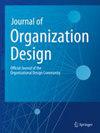组织的数字孪生:对组织设计的启示
IF 2.1
Q3 BUSINESS
引用次数: 0
摘要
最近在产品和过程中使用数字表示的兴起创造了一种使用“数字双胞胎”进行组织设计的运动。我们提供了数字孪生概念的概述,作为一种同步的、实时的双向交互的数字表示,它有望作为双胞胎复制现实世界的现象。现实世界和数字表现之间存在双向因果关系的说法,使得目前关于数字双胞胎的言论尤其成问题。为了把握组织的数字孪生(DTO)所涉及的挑战,我们从物的数字孪生(DTT)和业务流程的数字孪生(DTBP)开始。我们使用Peircean的符号关系理论来分析和比较不同类型的数字双胞胎,该理论区分了信号、图标和符号。我们假设,为了将组织完全建模为数字孪生,组织设计师需要对组织的特征进行建模,这些特征在数字孪生和数字孪生中不存在,例如代理、冲突和涌现。鉴于符号现象的不可避免的存在,我们推测在何种程度上可能走向完全的dto,更广泛的dto需要具有哪些特征,以及更广泛地使用dto将为组织设计师提供哪些好处。最后,我们为dto的研究议程提出了一些建议,这些建议有可能改善组织设计,并为组织设计理论做出贡献。本文章由计算机程序翻译,如有差异,请以英文原文为准。
Digital twins of organization: implications for organization design
Abstract The recent rise of using digital representations for products and processes has created a movement to use ‘digital twins’ for organization design. We provide an overview of the notion of digital twin as a synchronized, real-time two-way interacting digital representation of the real-world phenomenon it is expected to replicate as a twin. The claim of a two-way causal connection between the real-world and the digital representation makes the current rhetoric about Digital Twins especially problematic. To grasp the challenges involved in Digital Twins of Organizations (DTO), we start from Digital Twins of Things (DTT) and Digital Twins of Business Processes (DTBP). We analyze and compare different kinds of digital twins using Peircean theory of semiotic relationships, which differentiate between signals, icons, and symbols. We posit that in order to fully model organizations as digital twins, an organization designer needs to model features of organizations that are not present in DTTs and DTBPs, such as agency, conflict, and emergence. Given the inevitable presence of symbolic phenomena, we speculate to what extent it is possible to move towards full DTOs, what characteristics broader DTOs need to have, and what benefits more extensive use of DTOs will offer for organization designers. We finally offer pointers towards a research agenda for DTOs that have the potential to improve organization designs and contribute to theory on organization design.
求助全文
通过发布文献求助,成功后即可免费获取论文全文。
去求助
来源期刊

Journal of Organization Design
Business, Management and Accounting-Strategy and Management
CiteScore
3.50
自引率
0.00%
发文量
22
期刊介绍:
The Journal of Organization Design is the intellectual home of organization design thinking. Drawing on a wide variety of disciplines, organization design analyzes how organizations work, and how they can work better, focusing on the choices about structures, systems, and processes that drive various organizational outcomes.
The journal advances understanding of topics important to academic researchers and industry professionals alike. We aim to publish novel research and commentary on known or emerging organization design concepts and phenomena; examine new technologies for the design and management of organizations; derive practical implications from existing studies; and analyze new and unusual forms of organizing.
We welcome high-quality submissions that expand on the foundations of organization design and uncover new phenomena. Uniquely, authors can choose from numerous article formats, providing customized vehicles for expression. Articles are peer-reviewed, written, and read not only by design scholars, but also by managers within organizations.
 求助内容:
求助内容: 应助结果提醒方式:
应助结果提醒方式:


